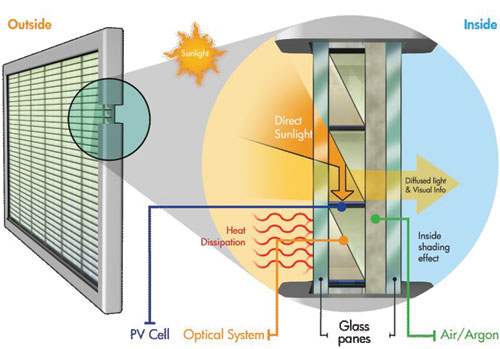Windows on Sustainability
Photovoltaic Glass Units
Photovoltaic glass (PV) has a significant part to play in getting buildings to net zero. Traditionally the building roof has been the province of PV products in the form of PV panels that needed their own support system and were limited by the space available. Most PV materials used in roofs are crystalline silicon; they have conversion efficiency of up to 13 percent and are typically opaque and rigid. Newer, thin-film PV cells are manufactured by depositing ultra-thin layers of semiconducting materials on glass or stainless steel sheets, and are a better fit for integration into building glazing materials. Thin-film PV is being integrated into vision glass for windows, skylights and facades, and opaque PV glass can also be produced for use as spandrel glass that, when coupled with PV vision glass, effectively turns the entire building envelope into an electric power generator, without the need to install PV panels separately on the roof.
 |
PVGUs incorporate advanced optics to turn sunlight into electricity. Image courtesy of Guardian Industries Corp. |
In a new category of green building material, manufacturers have combined proprietary optics, high-efficiency crystalline silicon, advanced materials science and simulation software to create a highly efficient photovoltaic glass unit (PVGU), essentially photovoltaics in a standard double-pane window form, known in the industry as an insulating glass unit or IGU. Virtually an insulated window with integrated photovoltaics, the PVGU is an energy-generating alternative to the IGU, while leveraging its modularity, ease of installation and acceptance by the design and building industry. This technology can offer high light transmission, significant up-front savings on HVAC systems and on-going energy costs, all while generating electricity for the building.
Opaque PV glass can also be produced to use as spandrel glass which shields structural building components such as columns, floors, HVAC systems, electrical wiring and plumbing from view. With intense market competition, the price of opaque PV spandrel has come down to a level that begins to approach insulated glass, making it a cost-effective solution especially on a sunny southern exposure. Manufacturers are offering an increasing range of glass configurations in both PV vision and spandrel glass. When combined, PV vision glass and opaque spandrel glass effectively turn the entire building envelope into an electric power generator.
The most advanced example of a PVGU is a high-density unit that uses prisms to collect direct sunlight by having a thin layer of monocrystalline silicon solar cells sandwiched horizontally between two layers of glass to form an individual tile, which acts as a cell. An internal plastic reflective prism directs sunlight onto the solar cells. Softer daylight and less intense horizontal rays are admitted through the window, minimizing glare and heat, creating a view for occupants and generating the same level of power of a roof top solar panel at the same orientation—in short, breaking the existing trade-off between high module efficiency and low transparency.
PVGUs offer a serious alternative to IGUs, and can have up to three times the power density while achieving low solar heat gain and a very high light-to-solar gain while optimizing daylighting and improving U-values. Optimal PVGU potential would be on the south, east and west facades of a building.
In November 2011, two existing windows on the south side of North America's tallest building, the Willis Tower, formerly the Sears Tower, were replaced by PVGUs. Each window is about one square meter and capable of generating 120W of power. Energy harnessed by the transparent solar windows is expected to reduce heat gain, and therefore cooling costs as well. If the experiment succeeds, the Willis Tower may increase its PVGU installation, becoming a virtual vertical solar generation farm.









